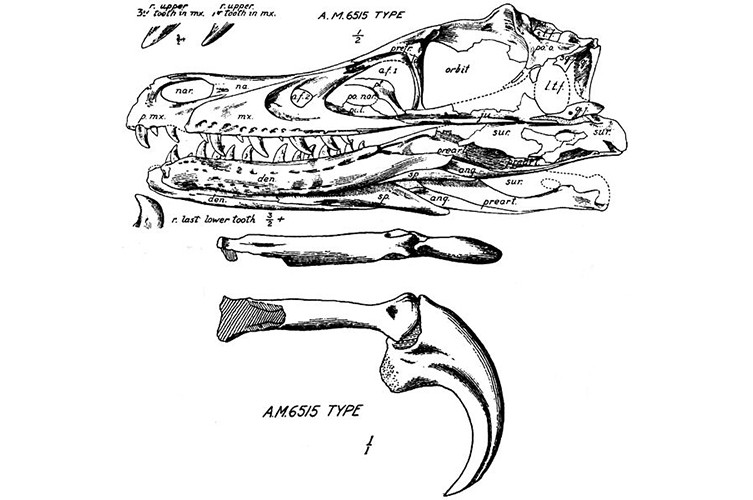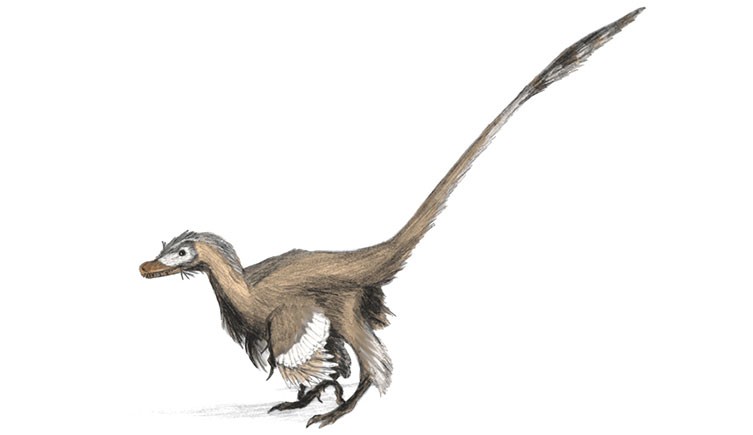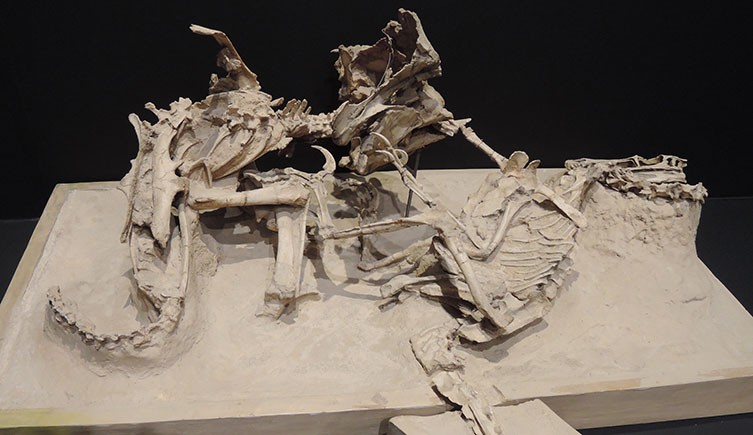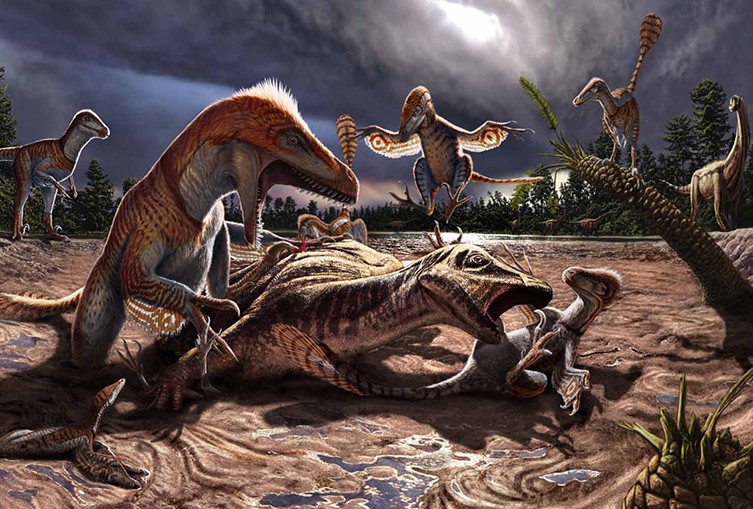Understanding the size of a Velociraptor compared to a human is crucial for grasping the true nature of this dinosaur. At COMPARE.EDU.VN, we provide a detailed comparison to help you visualize the difference. This comparison involves delving into historical finds, physical attributes, and behavioral traits.
1. Understanding Velociraptor Size
Velociraptor often portrayed as towering figures in popular culture, were, in reality, much smaller. The first Velociraptor fossil, discovered in 1923 in the Gobi Desert, offered initial clues. However, its true size has only been fully understood through subsequent discoveries and research.
1.1. Actual Size of a Velociraptor
Despite their fearsome reputation, Velociraptors were about the size of a turkey. Adults typically measured around 6.8 feet (2.07 meters) in length and stood approximately 1.6 feet (0.5 meters) tall at the hip.
- Length: Approximately 6.8 feet (2.07 meters)
- Height at Hip: Approximately 1.6 feet (0.5 meters)
- Weight: Roughly 33-100 pounds (15-45 kg)
1.2. Comparing Velociraptor Size to Humans
When comparing a Velociraptor to an average human, the size difference is considerable. An adult human, standing at an average height of 5.5 feet (1.68 meters), would tower over a Velociraptor. This contrast helps to contextualize the dinosaur’s actual dimensions versus its dramatized representation.
- Human Height: Approximately 5.5 feet (1.68 meters)
- Height Difference: Humans are significantly taller than Velociraptors
2. Physical Attributes of Velociraptor
Beyond their size, specific physical attributes made Velociraptors formidable predators. These features include their claws, feathers, and overall build, each playing a crucial role in their survival and hunting strategies.
2.1. The Infamous Claw
The Velociraptor‘s most distinctive feature is its large, curved claw on the second toe of each foot. This claw could grow to more than 2.5 inches (6.5 centimeters) around its outer edge.
- Claw Length: Over 2.5 inches (6.5 centimeters)
- Function: Used for stabbing and gripping prey
Initially, scientists believed this claw was used for disemboweling prey. However, research suggests it was primarily used for stabbing and securing prey, similar to the talons of an eagle.
2.2. Feathers and Appearance
Evidence suggests that Velociraptors were covered in feathers. Fossil discoveries, such as quill knobs on a Velociraptor fossil in 2007, confirm that they had long feathers attached to their arms. This feathered appearance would have made them resemble an unusual bird of prey.
- Feather Evidence: Quill knobs on fossils
- Appearance: Resembled a bird of prey with teeth and claws
The presence of feathers suggests they were used for warmth, display, and possibly brooding. While they couldn’t fly, the feathers played a crucial role in their thermoregulation and mating rituals.
2.3. Body Structure
Velociraptors had a slender, agile build suited for hunting. They possessed long, stiff tails that aided in steering at high speeds and muscular legs that enabled rapid bursts of speed.
- Build: Slender and agile
- Tail: Long and stiff for steering
- Legs: Muscular for speed
This body structure allowed them to be quick and effective hunters, capable of catching nimble prey. Their anatomy indicates a lifestyle that balanced speed and precision.
3. Velociraptor Behavior and Hunting
Understanding the behavior and hunting strategies of Velociraptors provides additional context to their capabilities and place in the prehistoric ecosystem.
3.1. Hunting Techniques
Velociraptors likely preyed on small mammals, reptiles, and occasionally infant dinosaurs. Their narrow jaws and light build suggest they primarily targeted smaller animals.
- Primary Prey: Small mammals and reptiles
- Occasional Prey: Infant dinosaurs
A fossil discovery even revealed a Velociraptor with a pterosaur bone in its stomach, indicating they sometimes scavenged or hunted larger prey opportunistically.
3.2. Pack Hunting Debate
The notion of Velociraptors hunting in packs is widely popularized but lacks strong evidence. While some fossil findings show multiple Deinonychus individuals around a larger herbivore, this could indicate scavenging or coincidental burial.
- Pack Hunting Evidence: Limited
- Alternative Explanations: Scavenging, mobbing behavior
Trackways of multiple individuals moving in the same direction do not conclusively prove pack hunting. The behavior might reflect flocking or following, rather than coordinated attacks.
3.3. Speed and Agility
Velociraptors were swift runners, estimated to reach speeds over 25 miles per hour (40 kilometers per hour) in short bursts. Their agility was enhanced by their stiff tail, which aided in maneuvering at high speeds.
- Estimated Speed: Over 25 mph (40 km/h)
- Agility: Enhanced by stiff tail
This speed and agility would have been crucial for capturing prey and evading larger predators. Their physical attributes made them formidable hunters in their environment.
4. Velociraptor Intelligence
Assessing the intelligence of Velociraptors involves examining their brain size relative to their body size. This measure, known as the encephalization quotient, provides insights into their cognitive abilities.
4.1. Encephalization Quotient
Velociraptors had a relatively high encephalization quotient compared to most reptiles and other dinosaurs. This suggests they were comparatively intelligent, though not on par with primates or even some modern birds.
- Intelligence Level: Relatively high for a dinosaur
- Comparison: Similar to an average bird, like a hawk
4.2. Cognitive Abilities
While not capable of outwitting humans as portrayed in fiction, Velociraptors likely possessed problem-solving skills and social behaviors comparable to modern birds of prey. Their intelligence would have aided in hunting, survival, and possibly communication within their species.
- Skills: Problem-solving, social behavior
- Capabilities: Hunting strategies, communication
Their cognitive abilities, combined with their physical attributes, made them successful predators in their prehistoric environment.
5. Velociraptor in Popular Culture vs. Reality
The depiction of Velociraptors in popular culture, particularly in movies like Jurassic Park, often differs significantly from scientific understanding.
5.1. Size Discrepancies
In movies, Velociraptors are often portrayed as much larger and more intimidating than they actually were. The movie versions typically depict them as being closer to 6 feet tall, whereas the real Velociraptors were only about 1.6 feet tall at the hip.
- Movie Size: Approximately 6 feet tall
- Actual Size: Approximately 1.6 feet tall at the hip
5.2. Feather Omission
Another significant discrepancy is the omission of feathers in popular depictions. Scientific evidence strongly supports that Velociraptors had feathers, yet this feature is often ignored in movies and other media.
- Movie Depiction: Featherless
- Scientific Evidence: Feathered
5.3. Behavioral Exaggerations
Movies often exaggerate the intelligence and pack hunting abilities of Velociraptors. While they were relatively intelligent for dinosaurs, they were not the cunning, coordinated hunters often portrayed.
- Movie Behavior: Cunning, coordinated pack hunters
- Actual Behavior: Likely opportunistic hunters with limited pack behavior
6. Key Velociraptor Discoveries
Several key fossil discoveries have shaped our understanding of Velociraptors.
6.1. The Fighting Dinosaurs Fossil
One of the most famous fossils is that of a Velociraptor locked in combat with a Protoceratops. This specimen provides a snapshot of dinosaur behavior, showing the Velociraptor‘s claw in the Protoceratops‘s throat and the Velociraptor‘s arm crushed in the Protoceratops‘s mouth.
- Significance: Direct evidence of dinosaur combat
- Details: Velociraptor and Protoceratops locked in battle
6.2. Pterosaur Meal Fossil
Another significant find is a fossil containing a Velociraptor‘s meal: a broken pterosaur bone. This discovery suggests that Velociraptors occasionally scavenged or hunted larger prey.
- Significance: Insight into Velociraptor diet
- Details: Fossil containing pterosaur bone
6.3. Feather Evidence Fossils
The discovery of quill knobs on Velociraptor fossils provided direct evidence of feathers. This finding revolutionized our understanding of their appearance and thermoregulation.
- Significance: Confirmation of feathers
- Details: Quill knobs on fossil bones
7. Velociraptor Habitat and Time Period
Understanding where and when Velociraptors lived provides additional context to their evolutionary development.
7.1. Habitat
Velociraptors lived in what is now Mongolia during the Late Cretaceous period. This region was characterized by arid environments with occasional rivers and oases.
- Location: Mongolia
- Environment: Arid with rivers and oases
7.2. Time Period
Velociraptors existed approximately 75 to 71 million years ago. This places them firmly in the Late Cretaceous period, just before the mass extinction event that wiped out the dinosaurs.
- Time Period: Late Cretaceous (75-71 million years ago)
- Significance: Lived shortly before the dinosaur extinction
8. Evolutionary Relationships
Velociraptors belong to the dromaeosaurid family, which is closely related to birds. This relationship is supported by numerous skeletal similarities and the presence of feathers.
8.1. Dromaeosaurid Family
The dromaeosaurid family includes other well-known dinosaurs such as Deinonychus and Utahraptor. These dinosaurs share similar features, including the distinctive sickle claw.
- Family: Dromaeosauridae
- Members: Deinonychus, Utahraptor
8.2. Bird Ancestry
Velociraptors are more closely related to birds than other dinosaurs like Oviraptor. This close relationship is evident in their skeletal structure, feathers, and possibly brooding behaviors.
- Relationship: Closer to birds than other dinosaurs
- Evidence: Skeletal similarities, feathers
9. Velociraptor Compared to Other Dromaeosaurids
Comparing Velociraptors to other dromaeosaurids helps to highlight their unique characteristics and evolutionary adaptations.
9.1. Deinonychus
Deinonychus was larger than Velociraptor, measuring around 11 feet in length. It also had a similar sickle claw but possessed a more robust build.
- Size: Larger than Velociraptor (11 feet)
- Build: More robust
9.2. Utahraptor
Utahraptor was the largest known dromaeosaurid, reaching lengths of up to 23 feet. Its sickle claw was also significantly larger than that of Velociraptor.
- Size: Largest dromaeosaurid (23 feet)
- Claw: Significantly larger
9.3. Size Comparison Table
| Feature | Velociraptor | Deinonychus | Utahraptor |
|---|---|---|---|
| Length | 6.8 feet (2.07 meters) | 11 feet (3.35 meters) | 23 feet (7 meters) |
| Height at Hip | 1.6 feet (0.5 meters) | ~3 feet (0.9 meters) | ~6 feet (1.8 meters) |
| Distinctive Trait | Relatively small size | More robust build | Largest dromaeosaurid |





10. The Legacy of Velociraptor
Despite their relatively small size, Velociraptors have left a significant mark on popular culture and paleontology.
10.1. Impact on Paleontology
The study of Velociraptors has contributed significantly to our understanding of dinosaur evolution, behavior, and the relationship between dinosaurs and birds.
- Contributions: Dinosaur evolution, behavior, bird relationship
- Significance: Advanced paleontological knowledge
10.2. Cultural Influence
Velociraptors have become iconic figures in movies, books, and other media, captivating audiences with their fearsome image and intriguing characteristics.
- Influence: Iconic figures in popular culture
- Appeal: Fearsome image and intriguing characteristics
The ongoing fascination with Velociraptors ensures they will remain a prominent part of our collective imagination for years to come.
FAQ: Velociraptor Size and Characteristics
1. How big was a Velociraptor compared to a human?
A Velociraptor was much smaller than a human, standing about 1.6 feet tall at the hip and measuring around 6.8 feet in length, while an average human is around 5.5 feet tall.
2. Did Velociraptors really have feathers?
Yes, there is strong evidence that Velociraptors had feathers, similar to modern birds.
3. How fast could a Velociraptor run?
Velociraptors could run at speeds of over 25 miles per hour (40 kilometers per hour) in short bursts.
4. What did Velociraptors eat?
Velociraptors primarily ate small mammals, reptiles, and occasionally infant dinosaurs.
5. Did Velociraptors hunt in packs?
The evidence for Velociraptors hunting in packs is limited; they may have been opportunistic hunters.
6. How smart was a Velociraptor?
Velociraptors were relatively intelligent for dinosaurs, comparable to the intelligence of an average bird like a hawk.
7. Where did Velociraptors live?
Velociraptors lived in what is now Mongolia during the Late Cretaceous period.
8. When did Velociraptors live?
Velociraptors lived approximately 75 to 71 million years ago, during the Late Cretaceous period.
9. How does the Velociraptor in Jurassic Park compare to the real dinosaur?
The Velociraptors in Jurassic Park are much larger, lack feathers, and are portrayed as more intelligent and coordinated than the real dinosaurs.
10. What is the most famous Velociraptor fossil?
The most famous Velociraptor fossil is the “Fighting Dinosaurs” specimen, which shows a Velociraptor locked in combat with a Protoceratops.
Make Informed Decisions with COMPARE.EDU.VN
Are you looking for detailed, objective comparisons to help you make informed decisions? COMPARE.EDU.VN provides comprehensive analyses of various topics, from historical facts to scientific discoveries. Don’t rely on incomplete information – visit COMPARE.EDU.VN today and discover the insights you need to make the best choices.
Contact Us:
- Address: 333 Comparison Plaza, Choice City, CA 90210, United States
- WhatsApp: +1 (626) 555-9090
- Website: compare.edu.vn
